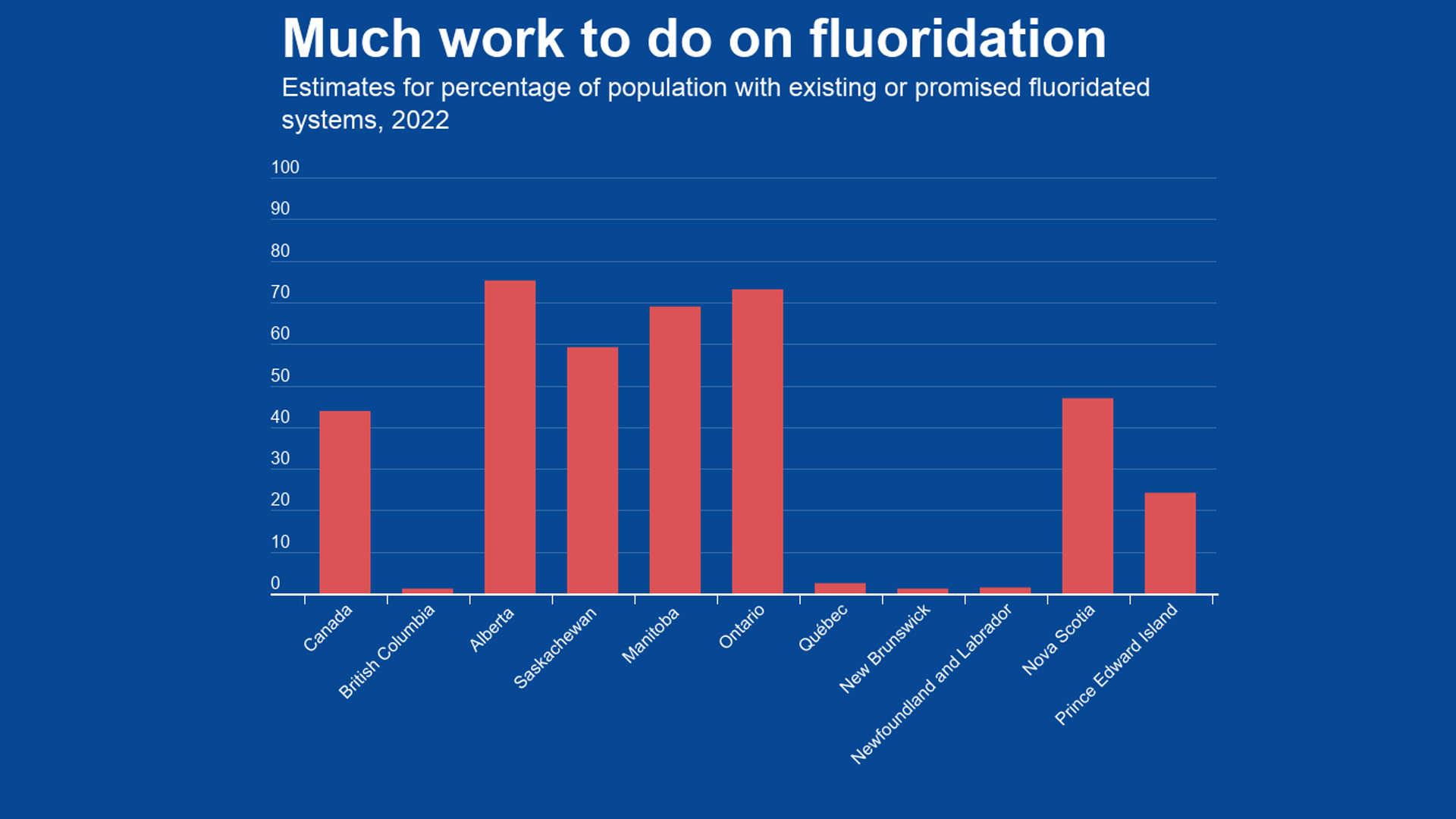
The federal government has announced in its 2022 budget that it will spend $5.3 billion over five years on a national dental care plan for many Canadians. The first people to benefit will be children, then low-income Canadians.
But prevention is better than treatment, and also less expensive. The best method of dental decay prevention is through community water fluoridation. This public health measure effectively helps everyone; it is safe, cost-effective and equitable. Fiscal responsibility means the federal government should support not just treatment but also prevention.
Fluoride refers to compounds containing the negative ion of the element fluorine. Community water fluoridation adjusts the naturally existing level of fluoride in the drinking water to 0.7 parts per million. Evidence over more than 75 years shows that this public health measure significantly reduces cavities in children and provides further benefits throughout life.
Since the 1960s, many Canadian cities have benefitted from fluoridation, including Toronto, Ottawa, Edmonton, Winnipeg, Hamilton, London, Halifax and Saskatoon. Windsor and Calgary had fluoridation and ceased it, although both cities have recently decided to reinstate it.
The Public Health Agency of Canada reported in 2017 that only 38.7 per cent of Canadians had fluoridated water. In Quebec, British Columbia, New Brunswick, Newfoundland and the Yukon, less than five per cent of the population had this benefit. By contrast, the United States Centers for Disease Control reported in 2018 that 63.4 per cent of the total U.S. population had fluoridated water.
Progress has been made in Alberta and Saskatchewan (the cities of Calgary and Regina recently approved water fluoridation), but elsewhere in the country little has changed in five years, except for a slight increase in Ontario. Water is still not fluoridated in several large cities, including Vancouver, Montreal and Quebec City, as well as in many smaller communities As shown in figure 1, water fluoridation remains almost non-existent in Quebec, British Columbia, New Brunswick and Newfoundland and Labrador.
Two controversies
Fluoridation, like vaccination, generates two controversies.
The first is whether the good of the community should prevail over the preferences of some individuals. The British Columbia Court of Appeal ruled in 2004 that when a majority votes for water fluoridation, a litigant cannot succeed in seeking fluoridation cessation. The Supreme Court of Canada refused to hear an appeal of this ruling.
The second issue concerns the torrents of misinformation that appear, even in the peer- reviewed literature. This false information must be countered by the continuous dissemination of reliable information from credible sources. The federal government, through the Public Health Agency of Canada, is in a strong position to communicate with dedicated, consistent messaging – in all the languages spoken across Canada. As voting showed in Windsor in 2018 and Calgary in 2021, when accurate information is presented, fluoridation is a prized community health benefit because of its many advantages, which are easily demonstrable.
Water fluoridation is effective in reducing dental decay by approximately 25-30 per cent in children and adults. That’s the main argument. Fluoride helps to prevent cavities both systemically (before the teeth emerge) and topically (on the tooth surface). Scientific studies in Calgary, Windsor and Juneau, Alaska clearly demonstrate that when fluoridation ceases, the rate of dental decay in children rises dramatically, even with the use of fluoride toothpaste.
Fluoridation is safe
Numerous national reviews, such as Australia, 2017, Ireland, 2018, and Canada, 2019 found no evidence for concern about water fluoridation. There is a small risk of minor tooth enamel discolouration, though such teeth are more resistant to decay. A Canadian study frequently cited by fluoridation opponents that claims fluoridation harms the brain has been discredited based on its methods and also by much better-designed studies with much larger populations.
Fluoridation is cost-effective
The Canadian Agency on Drugs and Technologies in Health conducted a budget impact analysis that reported that the savings from avoiding dental decay far outweigh the costs of implementing fluoridation, with cost effectiveness rising with the size of the population served by the water network. In Calgary, the cost of fluoridation is $1.01 per resident per year (using 2021 census data) with savings estimated at $54 annually. New technology makes fluoridation easy and cost-efficient even for rural and remote populations of only 50 people.
Fluoridation promotes equity
Dental decay is the most common chronic disease of childhood. Untreated dental decay prevents children from eating, sleeping, playing, concentrating and learning. Poor children in unfluoridated areas in the U.K. have 27 times increased risk of hospital admission for dental extractions than those in fluoridated areas. Dental decay disproportionately affects older people, Indigenous people, new Canadians and people with disabilities.
Our government should help the most vulnerable pay for dental treatment. But it is even more important to prevent dental decay through water fluoridation, just as seat belts are better than trauma care.
Yet, there is a gap in responsibility: water supplies are mostly controlled by municipal authorities, but local councillors have little background or understanding about fluoridation. The federal government can act within its jurisdiction: in water supplies for Indigenous communities and Canadian Forces bases.
As part of its new dental program, the Canadian government must help bring fluoridation to as many Canadians as possible, through provincially managed municipal grants if necessary. When people understand, they support such proposals. Therefore, the government must launch a national public health information campaign to tell all Canadians about the great benefits of water fluoridation.














